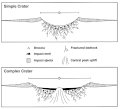
Tektites are gravel-sized bodies composed of black, green, brown or grey natural glass formed from terrestrial debris ejected during meteorite impacts. The term was coined by Austrian geologist Franz Eduard Suess (1867–1941), son of Eduard Suess. They generally range in size from millimetres to centimetres. Millimetre-scale tektites are known as microtektites.
Tollmann's bolide hypothesis is a hypothesis presented by Austrian palaeontologist Edith Kristan-Tollmann and geologist Alexander Tollmann in 1994. The hypothesis postulates that one or several bolides struck the Earth around 7640 ± 200 years BCE, and a much smaller one approximately 3150 ± 200 BCE. The hypothesis tries to explain early Holocene extinctions and possibly legends of the Universal Deluge.

Lake Elgygytgyn, also transcripted El'gygytgyn, is a crater lake in Anadyrsky District, Chukotka Autonomous Okrug in northeast Siberia, about 150 km (93 mi) southeast of Chaunskaya Bay.

Zhamanshin is a meteorite crater in Kazakhstan. It is 14 kilometres (8.7 mi) in diameter and the age is estimated to be 900,000 ± 100,000 years (Pleistocene). The crater is exposed at the surface.

Paleomagnetism is the study of prehistoric Earth's magnetic fields recorded in rocks, sediment, or archeological materials. Geophysicists who specialize in paleomagnetism are called paleomagnetists.
The Brunhes–Matuyama reversal, named after Bernard Brunhes and Motonori Matuyama, was a geologic event, approximately 781,000 years ago, when the Earth's magnetic field last underwent reversal. Estimations vary as to the abruptness of the reversal. A 2004 paper estimated that it took over several thousand years; a 2010 paper estimated that it occurred more quickly, perhaps within a human lifetime; a 2019 paper estimated that the reversal lasted 22,000 years.
A geomagnetic excursion, like a geomagnetic reversal, is a significant change in the Earth's magnetic field. Unlike reversals, an excursion is not a long-term re-orientation of the large-scale field, but rather represents a dramatic, typically a (geologically) short-lived change in field intensity, with a variation in pole orientation of up to 45° from the previous position.
A geomagnetic reversal is a change in a planet's dipole magnetic field such that the positions of magnetic north and magnetic south are interchanged. The Earth's magnetic field has alternated between periods of normal polarity, in which the predominant direction of the field was the same as the present direction, and reverse polarity, in which it was the opposite. These periods are called chrons.

Libyan desert glass or Great Sand Sea glass is an impactite, made mostly of lechatelierite, found in areas in the eastern Sahara, in the deserts of eastern Libya and western Egypt. Fragments of desert glass can be found over areas of tens of square kilometers. Like obsidian, it was knapped and used to make tools during the Pleistocene.
Wilkes Land crater is an informal term that may apply to two separate cases of conjectured giant impact craters hidden beneath the ice cap of Wilkes Land, East Antarctica. These are distinguished by the names Wilkes Land anomaly and Wilkes Land mascon (mass concentration), based on terms used in their principal published reference sources.
The Gauss–Matuyama Reversal was a geologic event approximately 2.58 Ma when the Earth's magnetic field underwent a geomagnetic reversal from normal polarity to reverse polarity. The reversal is named after German physicist Johann Carl Friedrich Gauss and Japanese geophysicist Motonori Matuyama.
The Jaramillo reversal was a reversal and excursion of the Earth's magnetic field that occurred approximately one million years ago. In the geological time scale it was a "short-term" positive reversal in the then-dominant Matuyama reversed magnetic chronozone; its beginning is widely dated to 990,000 years before the present (BP), and its end to 950,000 BP.
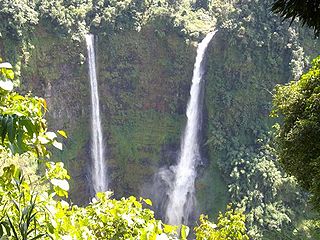
The Bolaven Plateau is an elevated region in southern Laos. Most of the plateau is located within Champasak Province of Laos, though the edges of the plateau are also located in Salavan, Sekong and Attapeu Provinces. It is located between the Annamite Range, along which runs Laos' eastern border with Vietnam, and the Mekong River to the west, at about 15°N106°E. The plateau's elevation ranges approximately from 1,000 to 1,350 metres above sea level. The plateau is crossed by several rivers and has many scenic waterfalls. The name Bolaven makes reference to the Laven ethnic group which has historically dominated the region. However, domestic migrations by the Lao ethnic group has resulted in widespread interethnic marriage, thus modifying the ethnic composition of the region.
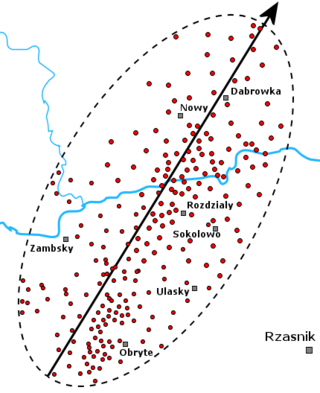
A strewn field is the area where meteorites from a single fall are dispersed. It is also often used for the area containing tektites produced by large meteorite impact.
Charles Carter Schnetzler was a planetary scientist at NASA's Goddard Space Flight Center. Schnetzler is best known for analyzing Moon rocks brought back by the Apollo program and for studying the Earth's environment using the Landsat and the Earth Observing System. Schnetzler was born in Whiting, Indiana and grew up in Neodesha, Kansas. On November 4, 2009, Schnetzler was seriously injured after being hit by a motorist while walking near his home on Little Patuxent Parkway in Columbia, Maryland. He later died in his home on December 15, 2009.
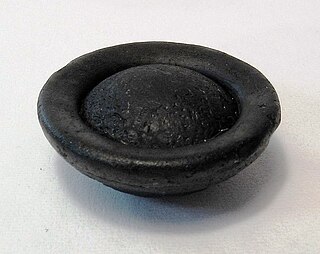
Australites are tektites found in Australia. They are mostly dark or black, and have shapes including discs and bowls that are not seen in other tektites. NASA used the shape of "flanged button" australites in designing re-entry modules for the Apollo program in the 1960s.
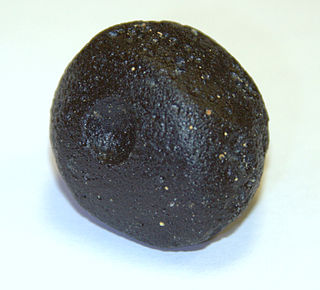
An Indochinite is a type of tektite. Tektites were ejected into the Earth's upper atmosphere by a meteorite impact and subsequently cooled to form the distinctive glass-like structure. Indochinites are distinctly dark black in contrast to the green of European moldavite tektites. It is estimated that these bodies of solidified magma are 700,000 years old. Indochinite tektites, as the name suggests, are found in the Indochinese peninsula, from Australia and the Pacific islands of Micronesia in the east and south, to China and Indonesia in the north and west. The largest indochinite is a Muong-Nong type tektite, which had a mass of 29.0 kg.

Tasmanite are tektites found in Tasmania, a regional form of australite, the most common type of tektite, glass of meteorite origin, traditionally named for its geographic location. Quite often, tasmanites are found in the literature under the name australites, together with which they are included in a very broad category of tektites, originating from the largest Australasian tektite strewnfield on earth. In the northern part of the scatter field, australites partially overlap and connect with part of the range of indochinites, and on the southern border they are present under the name tasmanites. In general, all of the listed regional tektites are included in the general class of indochinites-australites, sometimes referred to under the summary name Australasian tektites.














